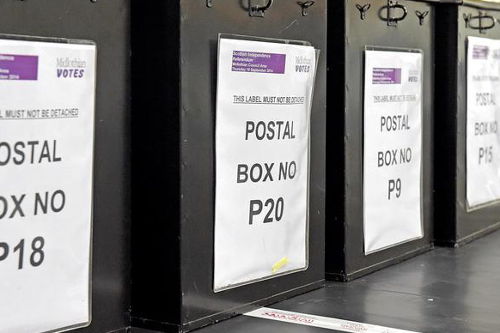Thursday May 5th 2016

The regional list is decided by the Additional Member System which is a form of proportional representation which aims to make the results of an election reflect more closely the amount of votes cast for each party or individual.
The Additional Member System combines First Past the Post in constituencies and a regional system which elects 56 additional members to the Parliament.
At a Scottish Parliament election, each voter has two votes; One is your Constituency Vote the other is your Regional vote.
The Constituency vote is used to elect the local constituency MSP. The constituency vote is counted and the person with the most votes wins. This is known as First Past the Post and is the same as for a Westminster election.
You use your second list vote to choose a political party, or a candidate standing as an individual, within a larger electoral area known as a region.
The region is made up of several constituencies.
The regional votes are counted and then Regional seats are decided using the D’Hondt Formula
How does the The D’Hondt Formula work
Victor D’Hondt was a Belgian mathematician.
Regional Votes are divided by the number of Constituency MSPs already won in the region + 1. The +1 is needed otherwise a party that got no constituency MSPs would be divided by zero.
The Party or person with the largest number after this formula is applied wins the first round and wins one regional MSP.
This formula will be used 7 times in 7 rounds to elect 7 regional MSPs.
Let’s take an example of a region
Our region is called “Anywhere”. It is made up of 9 constituencies. Voters could choose between six political parties; The Pink Party, the Spotty Party, the Black Party, the Striped Party, the Purple Party and the White Party
The Pink Party won 8 of these constituencies and the Black Party won the other.
Let’s look at the numbers we’re using and where they come from…
Round 1
Pink 99,000 ÷ (8+1) = 11,000
Spotty 85,000 ÷ (0+1) = 85,000
Black 47,500 ÷ (1+1) = 23,750
Striped 52,000 ÷ (0+1) = 52,000
Purple 23,000 ÷ (0+1) = 23,000
White 5,250 ÷ (0+1) = 5,250
In the regional vote, the Pink Party got 99,000 votes. It gained 8 constituency MSPs in the area that makes the region.
One is added to 8 to make the divisor for the Pink Party.
The D’Hondt formula for the Pink Party for round 1 is 99,000 ÷ (8+1). Their
result for round 1 is 11,000.
The Spotty Party got 85,000 votes in the regional ballot. They didn’t win any of the 9 constituencies in the region so the D’Hondt formula for them is 85,000 ÷ (0+1). Their result for round 1 is 85,000.
The Black Party has 47,500 votes from the regional ballot and they won 1 constituency in the region. The formula for the Black Party is 47,500 ÷ (1+1). Their result for round 1 is 23,750
The Striped, Purple and White Parties got 52,000, 23,000 and 5,250 votes. None of these parties won a constituency in the region, so their regional votes are divided by 0+1, giving them 52,000, 23,000 and 5,250.
So the result from round 1 is:
The Spotty Party has the largest number after the D’Hondt formula has been applied, so this Party gets 1 of the regional MSPs.
This formula would be used 7 times in 7 rounds to elect 7 regional MSPs.
Round 2
In Round 2, the Spotty Party’s divisor will change as they won an MSP in Round 1.
Pink 99,000 ÷ (8+1) = 11,000
Spotty 85,000 ÷ (1+1) = 42,500
Black 47,500 ÷ (1+1) = 23,750
Striped 52,000 ÷ (0+1) = 52,000
Purple 23,000 ÷ (0+1) = 23,000
White 5,250 ÷ (0+1) = 5,250
Striped Wins this round so this party gets an MSP.
Round 3
In Round 3, the same formula is applied again, this time however the Striped Party divisor changes.
Pink 99,000 ÷ (8+1) = 11,000
Spotty 85,000 ÷ (1+1) = 42,500
Black 47,500 ÷ (1+1) = 23,750
Striped 52,000 ÷ (1+1) = 26,000
Purple 23,000 ÷ (0+1) = 23,000
White 5,250 ÷ (0+1) = 5,250
Spotty Wins round 3
Round 4
In Round 4, the same formula is applied again, this time however the Spotty Party divisor changes.
Pink 99,000 ÷ (8+1) = 11,000
Spotty 85,000 ÷ (2+1) = 28,333
Black 47,500 ÷ (1+1) = 23,750
Striped 52,000 ÷ (1+1) = 26,000
Purple 23,000 ÷ (0+1) = 23,000
White 5,250 ÷ (0+1) = 5,250
Spotty Wins round 4
Round 5
In Round 5, the Spotty party divisor changes again.
Pink 99,000 ÷ (8+1) = 11,000
Spotty 85,000 ÷ (3+1) = 21,250
Black 47,500 ÷ (1+1) = 23,750
Striped 52,000 ÷ (1+1) = 26,000
Purple 23,000 ÷ (0+1) = 23,000
White 5,250 ÷ (0+1) = 5,250
Striped Wins round 5.
Round 6
In Round 6, the Striped Party divisor changes.
Pink 99,000 ÷ (8+1) = 11,000
Spotty 85,000 ÷ (3+1) = 21,250
Black 47,500 ÷ (1+1) = 23,750
Striped 52,000 ÷ (2+1) = 17,333
Purple 23,000 ÷ (0+1) = 23,000
White 5,250 ÷ (0+1) = 5,250
Black Wins round 6
Round 7
In Round 7, the Black Party divisor changes.
Pink 99,000 ÷ (8+1) = 11,000
Spotty 85,000 ÷ (3+1) = 21,250
Black 47,500 ÷ (2+1) = 15,833
Striped 52,000 ÷ (2+1) = 17,333
Purple 23,000 ÷ (0+1) = 23,000
White 5,250 ÷ (0+1) = 5,250
Purple Wins
So after all 7 rounds this is how the figures stack up
Final Regional Vote Totals
Pink 99,000 Number of Regional List MSPs 0
Spotty 85,000 Number of Regional List MSPs 3
Black 47,500 Number of Regional List MSPs 1
Striped 52,000 Number of Regional List MSPs 2
Purple 23,000 Number of Regional List MSPs 1
White 5,250 Number of Regional List MSPs 0
So now you know how the Additional Member System works.
Tweet Share on Facebook